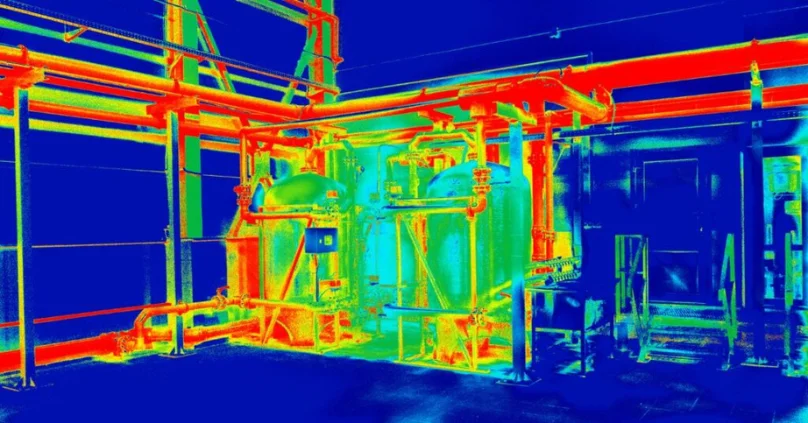
Thermal imaging technology is crucial for nighttime use, site inspections, and firefighting.
However, many of the tasks that require thermal imaging can often be hazardous. Drones are now widely used to ensure safety in various operations.
In this article, we’ll examine the use of thermal drones in various industries. We’ll also discuss the technologies that make thermal AI drones possible and how they revolutionized the global drone market.
What are the Uses of Thermal AI Drones?
Atoms in objects vibrate, which emits a heat signature based on how fast they move. Thermal imaging uses specialized lenses to capture infrared light from objects.
With a thermal camera, hot objects appear brighter. These are objects that absorb or emit plenty of heat. Meanwhile, cold objects tend to appear darker.
Thermal AI drones use this data along with advanced software for various operations. Here are a few applications of thermal drones around the world:
1. Search and Rescue
Search and rescue operations often take place in hazardous environments. Thermal drones, especially those powered by AI software, can help rescuers in all kinds of disasters.
Thermal drones can locate missing and trapped people in any environment. Their speed also means they can scan areas before first-response teams can get to the scene.
2. Fire fighting
Firefighting is another hazardous scenario where users need clear and accurate visual information.
Practical firefighting efforts require more than water or fire extinguishers. They also need coordination, especially in critical areas closest to residential or commercial zones.
An artificial intelligence drone can drastically improve firefighters’ coordination in open areas. In indoor spaces, drones can utilize heat mapping to identify potential points of structure failure.
3. Agriculture
Agriculture is another area where drones equipped with AI can shine. Using thermal drones, farmers can evaluate heat exposure and monitor crop and soil health.
Farmers can also use thermal drones to track animals at night. This prevents animals from going missing and allows farmers to monitor livestock health.
4. Safety Inspection and Maintenance
Certain pieces of infrastructure or equipment can be too dangerous to handle directly. However, they can be hard to spot for engineers on the ground.
AI-powered drones can do the job without putting inspection and repair teams at risk.
What are the Main Technologies Behind Thermal AI Drones?
Thermal drones are more than the sum of their parts. However, these parts make drones not just possible but viable as more industries look toward more efficient solutions.
Here are the primary technologies behind the artificial intelligence drone:
1. Artificial Intelligence
Artificial intelligence is the most significant technology, making AI drones a reality. It enables computers to simulate human learning, including problem-solving, decision-making, and comprehension.
There are a few other subsets of AI that focus on solving specific problems, such as:
- Neural networks – Neural networks are inspired by neurons in the human brain. Tasks like image recognition often use neural networks.
- Swarm intelligence – AI can also coordinate multiple drones. It can help them fly in patterns, exchange information, and communicate to finish tasks.
- Machine learning – Machine learning is the most common use of AI for drones. It allows machines to learn patterns and make data-based decisions.
2. Sensors and Cameras
Cameras are the primary way that drones gather data. High-resolution images and video provide the best data that image software can process. With accurate data, users can make better and more informed decisions.
Here are a few other sensors that drones can come with:
- Barometer – Barometers measure air pressure data, which drones use to calculate their altitude. Weather drones can also use this, along with pressure sensors, to collect weather data.
- Chemical sensors – Drones with gas and chemical sensors are used in industrial inspections and environmental monitoring.
- Li-DAR – Light Detection and Ranging works like radar but uses light instead of sound. Li-DAR sensors are often used to map terrain.
3. Edge Computing and Data Processing
In a nutshell, edge computing enables AI apps to run directly on field devices. Instead of connecting to a main network, they can process data on the field in seconds with machine learning.
AI-powered drones benefit immensely from edge computing technology. Edge computing includes networking solutions and hardware that allow smart devices to perform independently.
4 Frequently Asked Questions About Thermal Drones
With thermal drones performing more actions than before, it’s worth knowing more should you invest in them. Here are a few more things you should know about:
1. What’s the difference between a regular camera and a thermal camera drone?
Cameras are the most essential feature of drones, particularly AI-powered drones. The main difference is that thermal cameras have specialized lenses that capture infrared rather than regular light.
2. How do I maintain a thermal camera drone?
Thermal cameras are precision instruments and can be pretty sensitive. Avoid exposing the camera to powerful energy sources, like the sun. Doing so can throw off its sensitivity and damage it permanently!
3. How much do thermal drones cost?
Thermal drones can cost more depending on various features and the manufacturer. Entry-level drones can cost as much as $1-5,000. Meanwhile, more advanced models can set buyers back as much as $10-50,000.
4. Can AI for drones track human beings?
Yes! AI for drones can be good enough at object recognition to track more than just human beings. They can also track animals or other heat sources, such as pipelines or critical infrastructure.
The Bottom Line
As drones become more accessible, using thermal cameras and other sensors in drones is becoming more common. Their versatility and utility make them essential tools for more industries in the coming years.
If you want to see a high-performance thermal drone in action for your industry, look no further. Book a demo with us today—we’d love to hear from you!
